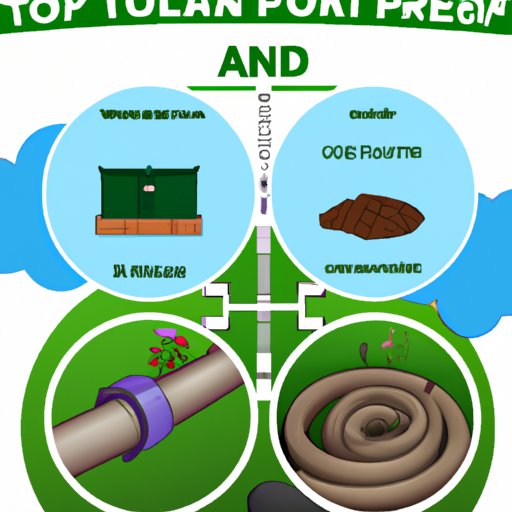Introduction
A septic tank is a self-contained wastewater treatment system that is used to treat and dispose of sewage and other contaminated water from residential, commercial, and industrial sources. It is designed to separate solids from liquids and to remove pathogens, organic matter, and other contaminants from wastewater before it is released into the environment. The septic tank is an important part of our wastewater management system and is essential for protecting public health and the environment.

An Overview of Septic Tank System Operation
The components of a septic tank system include a septic tank, distribution box, drain field, and effluent filter. The septic tank is a large, watertight container that receives raw sewage from the home or business. Inside the tank, the raw sewage is subjected to a process of separation and digestion. Solids settle to the bottom of the tank and are broken down by bacteria, while liquids are released through the outlet pipe and into the distribution box. The liquids then flow through the distribution box, which is used to evenly distribute the wastewater throughout the drain field. The drain field is a series of trenches or chambers filled with gravel and soil, where the wastewater is further treated and filtered before it is released into the environment.
In order to ensure the proper functioning of a septic tank system, it is important to monitor and maintain the system regularly. Regular inspections of the tank and drain field should be conducted to check for signs of wear or damage. Additionally, it is important to periodically clean the septic tank to prevent buildup of solids and scum. This can be done by pumping out the tank every three to five years depending on usage.

Understanding How Septic Tanks Work
Septic tanks come in a variety of sizes and designs, but all have the same basic purpose: to treat and dispose of wastewater. Most septic tanks consist of two chambers, separated by a dividing wall. The first chamber receives raw sewage from the home or business and allows solids to settle to the bottom. The second chamber is used to hold wastewater and allow it to further separate and settle out any remaining solids.
Once the wastewater enters the second chamber, it is treated using a combination of physical, chemical, and biological processes. Physical processes involve the removal of larger particles such as hair and food scraps. Chemical processes involve the addition of chlorine or other chemicals to kill bacteria and other organisms. Biological processes involve the use of bacteria to break down organic matter and remove nutrients.
After the wastewater is treated, it is released through the outlet pipe and into the drain field, where it is further treated and filtered. The drain field is typically made up of a series of trenches or chambers filled with gravel and soil, which provide additional filtration and help to disperse the wastewater into the surrounding soil. The wastewater is then released into the environment, where it is further filtered and purified by natural processes.

The Advantages and Disadvantages of Septic Tanks
Septic tanks offer many advantages, including cost savings and environmental protection. Because septic tanks are self-contained and require little maintenance, they can save money by eliminating the need for municipal wastewater treatment systems. Additionally, septic tanks help protect the environment by preventing pollutants from entering rivers, streams, and other bodies of water.
However, there are also some disadvantages to using septic tanks. For example, septic tanks require regular maintenance to ensure that they are functioning properly. Additionally, septic tanks can be expensive to install and may not be suitable for areas with high groundwater tables or areas with poor soil conditions. Furthermore, septic tanks can be a source of pollution if they are not properly maintained.
“Most of the time, septic tanks are reliable and effective wastewater treatment systems,” said Dr. Robert Schmieder, professor of civil and environmental engineering at the University of Michigan. “But it’s important to remember that they must be installed and maintained properly in order to function properly.”
Septic Tank Installation: What You Need to Know
Installing a septic tank system can be a complex process, so it is important to understand the costs and safety considerations involved. The cost of installing a septic tank system will vary depending on the size and type of system, as well as the local regulations and requirements in your area. In addition, it is important to hire a qualified professional to install the system to ensure that it is done correctly and safely.
When installing a septic tank system, it is also important to remember to follow all safety precautions. This includes making sure the area around the tank is clear of debris, wearing protective gear such as gloves and goggles, and avoiding contact with raw sewage. Additionally, it is important to make sure the system is correctly connected to the sewer line, and that all pipes, valves, and other components are securely sealed.
Conclusion
Septic tanks are an important part of our wastewater management system and are essential for protecting public health and the environment. They are cost-effective, easy to maintain, and can help reduce pollution. However, it is important to remember that they must be installed and maintained properly in order to function correctly. By understanding how septic tanks work and following safety precautions during installation, you can ensure that your septic tank system is functioning properly and safely.
(Note: Is this article not meeting your expectations? Do you have knowledge or insights to share? Unlock new opportunities and expand your reach by joining our authors team. Click Registration to join us and share your expertise with our readers.)
